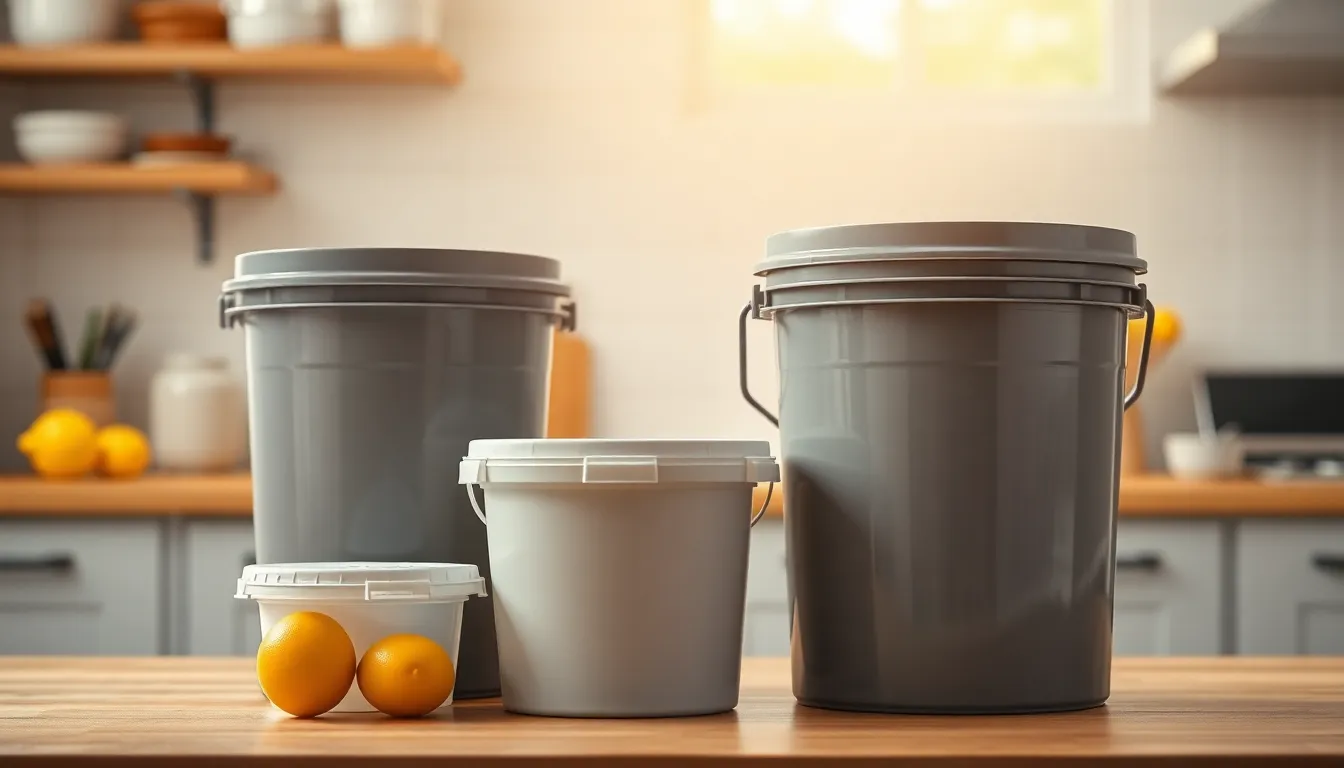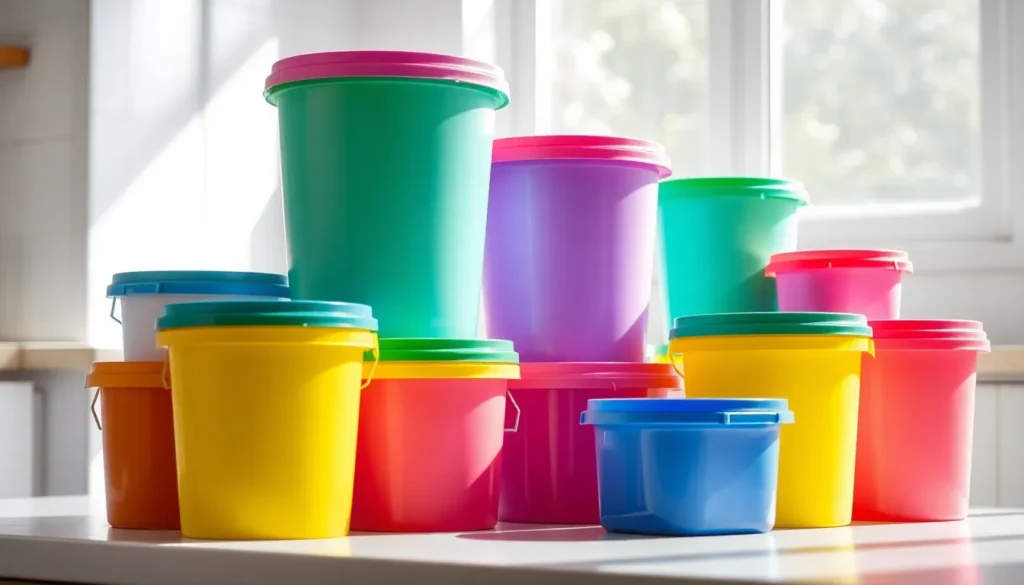When it comes to storing food, not all containers are created equal. Enter the unsung hero of the pantry: food grade buckets with lids. These sturdy, versatile containers aren’t just for the prepper in your life; they’re a game-changer for anyone looking to keep their grub fresh and safe. Think of them as the secret agents of food storage, stealthily protecting your ingredients from moisture, pests, and the occasional kitchen mishap.
Whether you’re a home chef trying to organize your flour supply or a weekend warrior prepping for a big BBQ, food grade buckets are your best pals. With airtight lids that seal in freshness and keep out unwanted guests, they make sure your food stays as delicious as the day you bought it. Plus, they’re stackable, durable, and ready to tackle anything from grains to leftovers. Who knew food storage could be this fun?
Table of Contents
ToggleOverview of Food Grade Buckets With Lids
Food grade buckets with lids serve crucial roles in food storage. Designed with safe materials, these buckets ensure that food remains free from contaminants. An airtight seal protects ingredients from moisture and pests, maintaining freshness over time.
Durable plastic constructions withstand changes in temperature, making them suitable for various environments, whether indoors or outdoors. Stackable designs optimize storage space, allowing for efficient organization in kitchens and pantries.
Food grade buckets are versatile and cater to different needs, from large-scale food prep to everyday ingredient organization. They often come in various sizes, accommodating anything from bulk grains to smaller quantities of spices. Lids typically fit snugly, preventing spills and reducing exposure to air.
Choosing food grade buckets ensures compliance with safety standards set by organizations like the FDA, confirming their suitability for food contact. Transitioning from traditional storage options to these buckets promotes greater food preservation and reduces waste.
Many users appreciate the added benefit of labeling, which lends itself well to keeping track of contents. Utilizing food grade buckets contributes to effective meal planning, offering a space-efficient solution for both home chefs and casual cooks.
Food grade buckets with lids represent an essential investment in kitchen organization, promoting safety and convenience in food storage. Their functionality makes them popular among various users, from families to event planners.
Benefits of Using Food Grade Buckets With Lids

Food grade buckets with lids offer numerous advantages for food storage. These containers ensure safety compliance and protection from various contaminants.
Safety and Compliance
Safety remains a top priority when selecting containers for food storage. Food grade buckets comply with safety standards established by organizations like the FDA. These regulations guarantee suitability for contact with food, ensuring no harmful chemicals leach into contents. Users can trust that the materials are non-toxic and free from BPA, safeguarding public health. Maintaining food safety becomes effortless when utilizing these certified containers.
Durability and Longevity
Durability is a key feature of food grade buckets. Designed from robust plastic, these buckets withstand temperature fluctuations without cracking. Long-lasting containers resist wear and tear, making them ideal for both indoor and outdoor storage needs. A sturdy construction prevents leaks and spills, securing contents over time. Optimal lifespan occurs when properly maintained, as these buckets can last for years, providing reliable service for extensive food storage requirements.
Types of Food Grade Buckets With Lids
Food grade buckets with lids come in various materials and sizes, catering to a wide range of storage needs. Understanding these options helps in selecting the right bucket for specific applications.
Material Options
Plastic ranks as the most common material for food grade buckets. Polyethylene and polypropylene are popular choices due to their durability and resistance to chemicals. These plastics meet safety standards established by organizations like the FDA, ensuring no harmful substances leach into food. Metal options, though less common, offer durability and can be used for both short and long-term storage. Glass buckets provide a non-reactive alternative, preserving the integrity of contents without altering flavors. Each material serves unique needs, making it essential to consider the intended use.
Size Variations
Size variations in food grade buckets range from small 1-gallon containers to large 5-gallon options. Smaller buckets are ideal for storing spices or smaller ingredient portions, while larger buckets accommodate bulk grains, flour, and other staples. This variety ensures that users can optimize their storage according to their volume requirements. In addition, 2.5-gallon and 3.5-gallon sizes fill the gaps for those who need something in between. Choosing the right size prevents waste and enhances organization in kitchens and pantries alike.
How to Choose the Right Food Grade Bucket With Lid
Selecting the appropriate food grade bucket with a lid requires careful consideration of several factors to ensure proper food storage.
Considerations for Storage
Storage requirements play a crucial role in choosing the right bucket. Assess the volume of food that needs storage. Smaller quantities might fit well in 1-gallon containers, while larger quantities necessitate 5-gallon options. Understand environmental conditions; buckets stored outside need robust materials that resist temperature changes. Think about location; indoor storage may require stackable designs for efficient space use. A tight-fitting lid contributes to food preservation by minimizing air exposure. Additionally, check for ease of cleaning; some materials may hold onto odors or stains more than others.
Tips for Purchasing
Examine material options carefully when purchasing. Polyethylene and polypropylene are common choices due to their durability and non-toxicity. Look for labels indicating BPA-free certification to ensure safety. Evaluate transparency; some buckets are translucent, allowing for easy visibility of contents. Compare prices across various suppliers to identify the best value. Consider additional features like handles for easy transportation or labeling space for effective organization. Seek recommendations or reviews from other users to gain insights about reliability and performance. This information helps in making an informed decision.
Maintenance and Care for Food Grade Buckets
Maintaining food grade buckets ensures longevity and cleanliness. Regular cleaning prevents contamination, so users should wash buckets with warm, soapy water after each use. Rinsing thoroughly removes soap residue, which is crucial for food safety.
Inspecting buckets for cracks or damage also plays a vital role. Damage can compromise the integrity of food storage, leading to spoilage. Users must replace any compromised buckets immediately to maintain safety.
Proper storage conditions further enhance the lifespan of food grade buckets. Avoiding direct sunlight prolongs material durability, as UV exposure can degrade plastic over time. Indoor storage is often preferable, especially in climate-controlled environments.
Labeling buckets aids organization and simplifies inventory management. Clear labels indicate contents, expiration dates, and specific uses, making identification effortless for users. Using waterproof materials for labeling ensures that information remains legible even in humid conditions.
Choosing the right temperature for food grade buckets is essential. Extreme heat or cold may impact the functionality of the plastic, so maintaining a stable environment is beneficial. Storing buckets in areas with consistent temperatures helps preserve food quality.
Additionally, using lids effectively supports food preservation. Tight-fitting lids help maintain freshness and keep contaminants out, reducing spoilage risks. Regularly checking the seals for wear ensures that food remains protected.
Following these maintenance guidelines guarantees that food grade buckets remain reliable storage solutions. Users can maximize the advantages of these containers by prioritizing care, leading to efficient and safe food storage in kitchens and pantries.
Food grade buckets with lids are invaluable tools for anyone serious about food storage. Their durability and safety features ensure that food stays fresh and uncontaminated, making them a smart choice for both home and professional kitchens. With a variety of sizes and materials available, these buckets cater to diverse storage needs while optimizing space.
By following maintenance guidelines and choosing the right type, users can maximize the benefits of these containers. Investing in food grade buckets not only enhances organization but also promotes a safer food storage environment. Whether for bulk ingredients or everyday use, these buckets are essential for efficient kitchen management.

